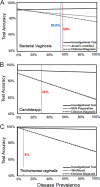Diagnostic Performance of a Molecular Test versus Clinician Assessment of Vaginitis
- PMID: 29643195
- PMCID: PMC5971525
- DOI: 10.1128/JCM.00252-18
Diagnostic Performance of a Molecular Test versus Clinician Assessment of Vaginitis
Abstract
Vaginitis is a common complaint, diagnosed either empirically or using Amsel's criteria and wet mount microscopy. This study sought to determine characteristics of an investigational test (a molecular test for vaginitis), compared to reference, for detection of bacterial vaginosis, Candida spp., and Trichomonas vaginalis Vaginal specimens from a cross-sectional study were obtained from 1,740 women (≥18 years old), with vaginitis symptoms, during routine clinic visits (across 10 sites in the United States). Specimens were analyzed using a commercial PCR/fluorogenic probe-based investigational test that detects bacterial vaginosis, Candida spp., and Trichomonas vaginalis Clinician diagnosis and in-clinic testing (Amsel's test, potassium hydroxide preparation, and wet mount) were also employed to detect the three vaginitis causes. All testing methods were compared to the respective reference methods (Nugent Gram stain for bacterial vaginosis, detection of the Candida gene its2, and Trichomonas vaginalis culture). The investigational test, clinician diagnosis, and in-clinic testing were compared to reference methods for bacterial vaginosis, Candida spp., and Trichomonas vaginalis The investigational test resulted in significantly higher sensitivity and negative predictive value than clinician diagnosis or in-clinic testing. In addition, the investigational test showed a statistically higher overall percent agreement with each of the three reference methods than did clinician diagnosis or in-clinic testing. The investigational test showed significantly higher sensitivity for detecting vaginitis, involving more than one cause, than did clinician diagnosis. Taken together, these results suggest that a molecular investigational test can facilitate accurate detection of vaginitis.
Keywords: Amsel's test; Nugent score; bacterial vaginosis; candidiasis; clinician diagnosis; diagnostic accuracy; molecular test; sensitivity; specificity; trichomoniasis; vaginitis; wet mount microscopy.
Copyright © 2018 Schwebke et al.
Figures



References
-
- Amsel R, Totten PA, Spiegel CA, Chen KC, Eschenbach D, Holmes KK. 1983. Nonspecific vaginitis. Diagnostic criteria and microbial and epidemiologic associations. Am J Med 74:14–22. - PubMed
Publication types
MeSH terms
Substances
Grants and funding
LinkOut - more resources
Full Text Sources
Other Literature Sources
Medical
Miscellaneous

